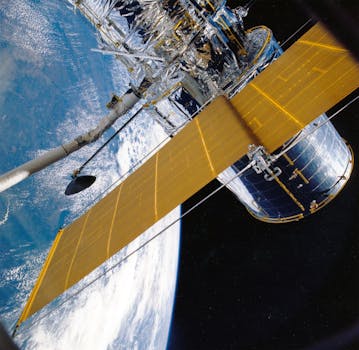The Future of Satellites: Revolutionizing Global Connectivity
The future of satellites is poised to revolutionize global connectivity, enabling faster and more reliable communication networks. With advancements in space technology, satellites are becoming increasingly important for various applications, including telecommunications, navigation, and Earth observation.

The Future of Satellites: Revolutionizing Global Connectivity
The future of satellites is poised to revolutionize global connectivity, enabling faster and more reliable communication networks. With advancements in space technology, satellites are becoming increasingly important for various applications, including telecommunications, navigation, and Earth observation. The focus keyword future of satellites is a crucial aspect of this revolution, as it encompasses the latest developments and innovations in the field.
Satellites have been a vital part of modern communication systems for decades, providing a means of transmitting data, voice, and video signals over long distances. However, the traditional satellite industry is undergoing a significant transformation, driven by technological advancements, changing market demands, and the emergence of new players. The future of satellites is expected to be shaped by several key trends, including the proliferation of small satellites, the development of reusable launch vehicles, and the increasing use of satellite constellations.
Advancements in Space Technology
One of the primary drivers of the future of satellites is the rapid advancement of space technology. Recent breakthroughs in areas such as materials science, propulsion systems, and satellite design are enabling the development of more efficient, cost-effective, and capable satellites. For example, the use of advanced materials and 3D printing techniques is allowing for the creation of lighter, more compact satellites that can be launched into orbit at a lower cost. Additionally, the development of more efficient propulsion systems, such as electric propulsion, is enabling satellites to operate for longer periods and travel greater distances.
Another key area of advancement is in the field of satellite communications. The development of higher-frequency bands, such as Ka-band and Q/V-band, is enabling faster data transfer rates and higher-capacity communications. This is particularly important for applications such as broadband internet access, where high-speed data transfer is critical. Furthermore, the use of advanced modulation techniques, such as beam-hopping and frequency-hopping, is allowing for more efficient use of satellite bandwidth and increased network capacity.
Applications of Satellites
Satellites have a wide range of applications, from telecommunications and navigation to Earth observation and scientific research. In the field of telecommunications, satellites are used to provide broadband internet access, mobile phone networks, and television broadcasting. They are also used for navigation, providing location information and timing signals for GPS and other satellite navigation systems.
In the area of Earth observation, satellites are used to monitor the environment, track weather patterns, and detect natural disasters. They are also used for scientific research, such as studying the Earth’s climate, monitoring ocean currents, and observing the universe. The future of satellites is expected to see an increase in the use of satellites for these applications, as well as the development of new applications, such as satellite-based Earth observation and satellite-enabled IoT networks.
Challenges and Opportunities
Despite the many opportunities presented by the future of satellites, there are also several challenges that must be addressed. One of the primary challenges is the issue of space debris, which poses a significant risk to operational satellites and the environment. The increasing number of satellites in orbit is also raising concerns about congestion and interference, which could impact the performance and reliability of satellite networks.
Another challenge is the need for greater international cooperation and regulation, to ensure that the benefits of satellite technology are shared equitably and that the risks are mitigated. This includes the development of standards and guidelines for the responsible use of satellites, as well as the creation of international agreements for the governance of space activities.
However, the future of satellites also presents many opportunities for innovation and growth. The development of new satellite technologies and applications is expected to create new industries and job opportunities, and to drive economic growth and development. Additionally, the use of satellites for social and environmental purposes, such as disaster response and environmental monitoring, is expected to have a significant positive impact on society and the environment.



